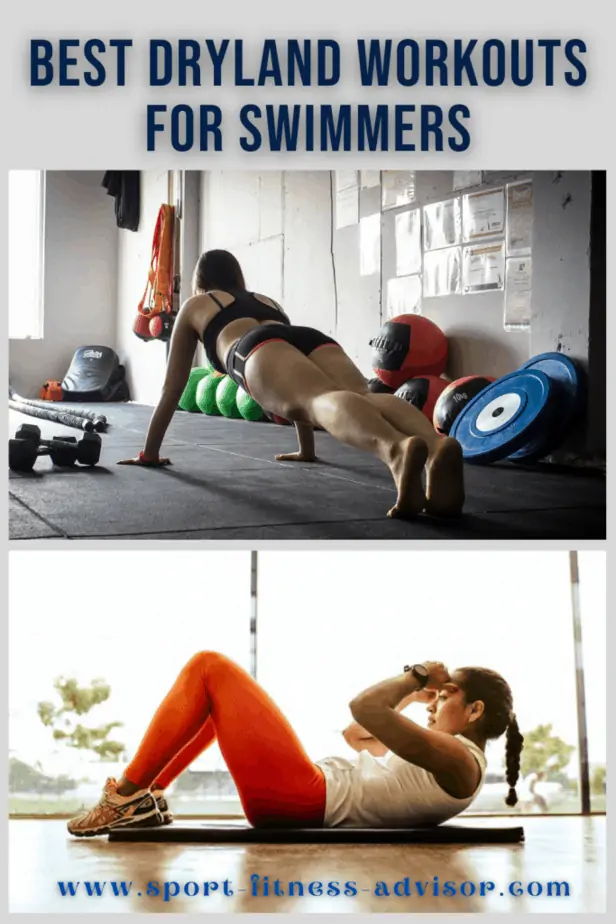Dryland training for swimmers also referred to as strength and conditioning training, consists of workouts on land that swimmers do to increase their strength, flexibility, posture, and overall physical mobility.
Dryland workouts for swimmers are designed to complement the training they do in the water by providing a foundation of strength, power, and mobility to improve performance in the water. These workouts not only build muscle strength and overall power they help to build core strength, improve posture, and fix any muscle imbalances that the swimmer might be experiencing.
What is Dryland Training?
Dryland training comprises land-based workouts designed to complement the workouts swimmers do in the water. They are designed in the same way swim workouts are and include a variety of different exercises and movements ranging from beginner to advanced skill level.
These can include basic, standard exercises such as sit-ups, push-ups, squats, and pull-ups to advanced swimmer-specific exercises such as resistance band workouts, medicine ball throws, and banded hip bridge holds.
Dryland training workouts are designed to build strength, power, and mobility.
Why is Dryland Training Important?
The goal of any dryland program for swimmers is to become stronger and more explosive in the water without increasing the risk of injury. Therefore, it is important to incorporate dryland training into your daily swim training routine for three main reasons:
- To Prevent Injury: Dryland workouts help to build core strength and correct muscle imbalances
- Increases Stroke Rate: Increasing strength and power allows you to take more strokes in less time in the water
- Improves Distance Per Stroke: Swimming with more power per stroke allows you to swim further with less effort
Best Dryland Exercises for Swimmers
The best dryland workouts for swimmers include exercises that stretch and strengthen the muscles that are most used in swimming, particularly the core, arms, and legs. These include:
- Pushups
- Pullups
- Squats
- Burpees
- Jump Lunges
- Planks
- Donkey Kicks
- Leg Lifts
- Jump Rope
- Medicine Ball
- Flutter Kicks
Five Best Low Impact Dryland Exercises for Core Strength
Swimming is based around the core of the body and a strong core is vital for swimmers as it can help with balance, posture, stability, strength, and flexibility both in and out of the water. Solid core strength helps swimmers with body position in the water, underwater kicking, and flip turns, as well as an explosive start off the blocks.
Certain swimming-specific dryland exercises help to strengthen the core which can be incorporated into the best dryland workouts for swimmers.
1. The Plank
This exercise replicates the correct body position in the water and focuses on building core strength. Focus on keeping your body in a straight line, engaging your core and glutes, and squeezing your belly button to your spine.
2. Russian Twists
Russian Twists are a core-focused exercise that works the torso with rotating movements that are very similar to freestyle swimming. This exercise helps to build control and strength around the core and will prevent corkscrew twisting in the water, as well as improve your speed.
Sit on the ground and bend your knees so that they are a few inches into the air. Lean back until you can feel your core engage. Now turn your upper body to one side and touch the ground, then do the same on the other side.
You can add a medicine ball or weights of some kind to make this exercise even more effective. Movements should be slow and controlled without allowing your legs to turn, drop or move around.
3. Superman
The Superman is a must for working your abs, core, shoulders, and lower back muscles. This is an excellent exercise for improving posture and preventing swimmer’s shoulder or rotator cuff injuries, which are a common swimming ailment.
Lay on your stomach on the ground and extend both arms in front of you. Raise one arm above the ground while lifting the opposite leg. Hold for a few seconds, then switch. Movements should be slow, fluid, and controlled and the longer you hold the pose, the stronger your core will become.
4. Raised Leg Crunch
Raised leg crunches work the core without the need for any equipment. Simply lay on your back and slowly lift your legs to a 90-degree angle. Place your hands behind your head. Now lift your head and shoulders off the ground and crunch toward your legs. Slowly lower your head and repeat!
5. Flutter Kicks
This exercise mimics the kicking movement in the water and helps to improve the core strength you’re your kick at the same time. Lay on the ground on your back and lift your legs a few inches off the ground to work your core and hip flexors.
Warming Up and Dynamic Stretching
Stretching before any form of exercise is essential to warm the body up and prevent injury. Dynamic stretching helps to loosen tight muscles and joints, which play an important role in swimming performance. The benefits of dynamic stretching before beginning your dryland workout includes:
Preventing injury
- Reducing muscle imbalances to ensure proper muscle engagement while swimming
- Improving body position and posture
- Aiding muscle recovery
Dynamic stretching is an essential part of your dryland workout and should always be included before you begin. It is also a good idea to add a few post-swim workouts stretching sessions to keep your muscles flexible and help to get rid of any lactic acid that is retained in the muscles after working out.
Dynamic stretching is an essential part of your dryland workout.
Five Best Dynamic Stretches for Swimmers
1. Shoulder Stretch
The shoulders are used in swimming a lot and are put under a lot of strain in hard workouts. It is vital to keep your shoulder injury-free by maintaining flexibility and mobility. These classic shoulder stretches help to loosen tight muscles and combat shoulder pain.
Pull one arm across your body and hold for 20 – 30 seconds on each side. Do this stretch two to three times until your shoulders feel loose and flexible. Remember to keep the shoulder you are stretching down – it may begin to creep upwards if it is very tight.
2. Lying Twist
This is a fantastic stretch for loosening out your lower back and opening up your chest. Lay on your back and gently twist both your knees to one side while keeping your shoulders flat on the ground.
Hold the stretch for 30-60 seconds on each side to get the maximum effect. If the intensity is too great, use a pillow to prop your knees up while stretching.
3. Cobra Pose
Lengthen and strengthen your core and build muscle around your spine with this yoga posture Cobra Pose stretch. Your toes must be flat on the ground, and your shoulders down. If the stretch is too much for you in the beginning, start on your elbows and work your way up to your hands. Try 1-2 sets of 15 – 30 seconds each before and after your workout.
4. Figure 4 Stretch
Flexible hips are essential to being comfortable in the water and tight hips can cause a range of problems from lower back pain to poor posture. This Figure 4 stretch helps to loosen the hips and make them more flexible which will contribute to swimming all four strokes better, as well as correct imbalances such as poor posture and lower back pain.
Your head must be flat on the ground and you must press the knee of the leg you are stretching forward. Hold this stretch for 30 – 60 seconds and repeat until your hips feel more flexible.
5. Hip Flexor Stretch
This stretch is essential for breaststrokers as the hip flexors need to be very flexible for breaststroke. Tight hip flexors and quad muscles can cause injury, back pain, and affect your posture, so this is a great stretch to do before and after your workout.
Make sure your back is flat on the ground and your tailbone is tucked under your body. Hold the stretch for 30-60 seconds on each side.
Five Best Resistance Band Dryland Exercises for Swimmers
Resistance bands or stretch cords are one of the most popular pieces of dryland equipment that swimmers use. This versatile piece of equipment helps to mimic the strokes as they are swum in the water, which in turn helps to build full-body strength and correct muscle imbalances that can lead to injuries.
Resistance bands can be used for a wide variety of movements that engage various muscle groups used in the water. They can also be used to work on stroke mechanics by mimicking the stroke out of the water. They are available in a range of weights and some come with handles and attachments that can be connected to any stable surface.
1. Swim Pull for Butterfly
Resistance bands can simulate your butterfly and freestyle pull and help you work on your body positioning in the water. For simulating butterfly, grip the handles of the bands, and pull both hands toward you as if you were pulling through the water during butterfly. Return to the starting position with control and repeat.
2. Swim Pull for Freestyle
You can also work on your freestyle pull with resistance bands, build strength, and improve your stroke rate in the water. Stand in an athletic stance with your knees bent and arms extended forward next to your head.
Grip the handles of the resistance bands and pull one arm down toward your hip. Alternate your arms and repeat as quickly as you can.
3. Band Internal and External Rotations
This is a great exercise for preventing common swimming injuries such as rotator cuff injuries. You can work both the inside and outside muscles of the shoulders with these internal and external rotation exercises.
Stand with the band on your left or right side. For internal rotations, pull the band across the front of your body, keeping your elbow bent at 90 degrees. For external rotations, pull the band away from your body, opening your chest and keeping your elbow bent 90 degrees.
4. Band T, Y, Is
This exercise is an essential move to build shoulder strength. Stand facing the attachment points of the bands, grip the handles, and pull the bands with straight arms to form a T, Y, and I position. Make sure to press your thumbs behind you. Use one arm at a time if the resistance is too much using both hands.
5. Kneeling Pallof Press
The Kneeling Pallof Press works the deep core muscles and helps to prevent injuries and maximize muscle engagement in the pool. Kneel on your right knee and hold the band on your right side.
Grab the band with both hands and stretch your arms straight out until they are even with your shoulders. Pull both your hands into the chest and slowly press back out. Keep the core stable and repeat on both sides.
Equipment Needed for Dryland Workouts
Dryland workouts can be conducted in a gym with standard equipment and exercise machines or with a combination of machines and exercise pieces such as skipping ropes, medicine balls, stretch cords (resistance bands), and Bosu balls. As dryland workouts increase in difficulty, more dryland equipment is required for each exercise.
Equipment needed includes medicine balls, jump ropes, and resistance bands.
Best Dryland Workouts for Swimmers (Beginners)
Dryland exercises using your body weight and a few pieces of equipment are a great way to build muscle strength, align your posture, and increase flexibility. Here are some basic dryland workouts that target the shoulders, quads, posterior chain, core, and chest and encompass strength and conditioning to increase power, mobility, and flexibility.
- Duration: 2 weeks
- Workouts: 4 (2 x week)
- Average workout: 15-20 minutes each
- Equipment: None
Warm-Up
10 x arm swings in all directions: front, back, double front, double back, alternating
10 x leg swings front-back, side-to-side
10 x dead-bugs
20 x jumping jacks
Hip-bridge hold for 30 seconds
Front plank for 30 seconds
Jump rope for 60 seconds
Main Set
3 x 15 push-ups – 30-second rest in between sets
3 x 15 bodyweight squats – 30-second rest in between sets
3 x 15 mountain climbers – 30-second rest in between sets
3 x 15 lunges – 30-second rest in between sets
Reps can be increased to sets of 20 as body strength increases.
Medicine balls are a great way to build core strength.
Best Dryland Workout for Swimmers (Intermediate)
This dryland workout is designed with an emphasis on squats and using resistance bands, StretchCordz, and a medicine ball. Squats are a swim-specific exercise that helps to build strength and power in the quad and calf muscles which provides explosive power off the blocks and the wall during flip-turns in the water. Each time you do a flip-turn in the water, you are essentially doing a squat, so these dryland exercises have tangible benefits.
- Duration: 6 weeks
- Workouts: 18 (3 x week)
- Average workout: 25-30 minutes each
- Equipment: Resistance bands / StretchCordz / Skipping rope / Medicine ball or pull-up bar
Warm-Up
10 x arm swings in all directions: front, back, double front, double back, alternating
10 x leg swings front-back, side-to-side
20 x dead-bugs
2 x 10 resistance band pull-aparts
Hip-bridge hold for 30 seconds
Front plank for 30 seconds
Jump rope for 60 seconds
Main Set
10 x StretchCordz freestyle pull for 30 seconds – 30-second rest in between sets
10 x 5 pull-ups or 10 single-arm medicine ball slams- 30-second rest in between sets
10 x 30-second bodyweight squats – 30-second rest in between sets
10 x 15 squat jumps- 30-second rest in between sets
Core
3×30 flutter kicks on your back
3×30 Russian Twists
3×30 mountain climbers
Recovery
15-minute stretch
Resistance bands help to mimic the strokes on land.
Dryland Workout for Swimmers (Advanced)
This advanced dryland workout for swimmers is designed for developing endurance, power, and speed.
The main set is meant to simulate swimming with maximum effort in the water, with enough rest to keep effort and power output at a high level.
- Duration: 4 weeks
- Workouts: 16 (4 x week)
- Average workout: 30-40 minutes each
- Equipment: Resistance bands / StretchCordz / Skipping rope / Medicine ball or pull-up bar / Foam Roller
Warm-Up
10 x arm swings in all directions: front, back, double front, double back, alternating
10 x leg swings front-back, side-to-side
20 x dead-bugs
2 x 10 resistance band pull-aparts
2 x hip-bridge hold for 30 seconds
2 x front plank for 30 seconds
2 x jump rope for 60 seconds
2 × 10 med ball slams against the floor
5 x squat jumps at maximum height
Main Set
8 x 30-second set of butterfly pull with StretchCordz – 30-second rest in between sets
8 x 30-second set of squat jumps with medicine ball
8 x 30-second set of freestyle pull with StretchCordz – 30-second rest in between sets
Core
3 × 30 flutter kicks on your back
3 × 30 Russian twists
3 × 30 mountain climbers
3 × 20 banded glute bridge marches
Recovery
15-minute stretch with a foam roller
Always warm up before beginning your dryland workout.
Final Thoughts
Dryland workouts are designed to complement your swimming workouts by building muscles, increasing flexibility, and improving overall body posture. If done correctly, and consistently, you will notice a marked difference in your swimming ability and overall strength within a few weeks.

Mia Russell is currently the head swim coach at Aquasharks Swimming Academy in South Africa. She has worked as the head swim guide at SwimQuest Open Water Swimming Holidays in London and was previously a Swim Coach at Cybersmart Aquatics. She has a AIDA International Level 3 Freediving Certification, PADI Open Water Advanced Certificate, SSI Level 1 Free Diver Certificate and RYA Beach Lifeguard Certificate.







